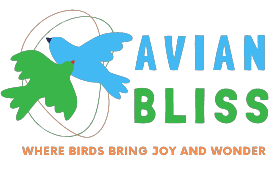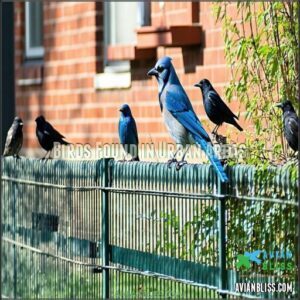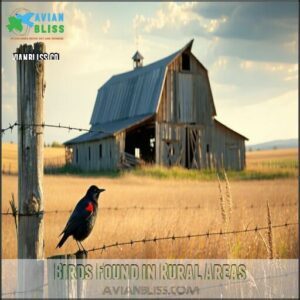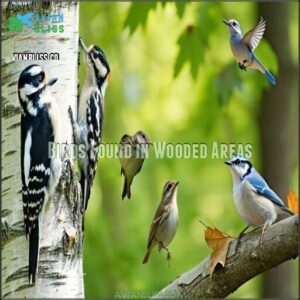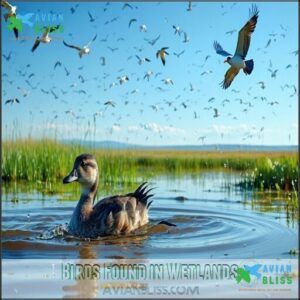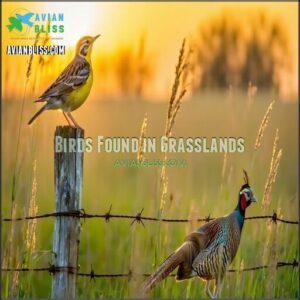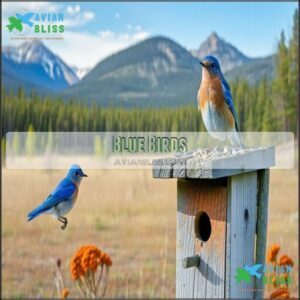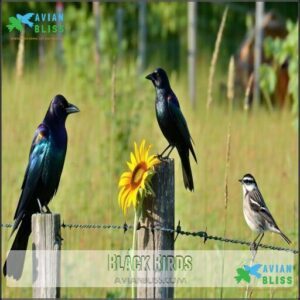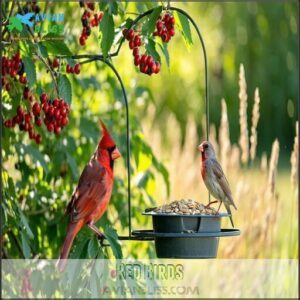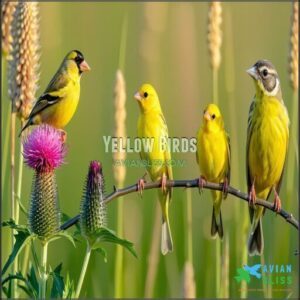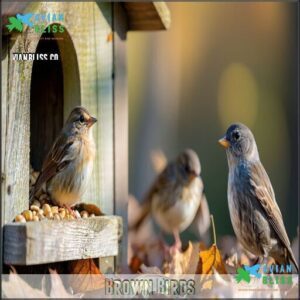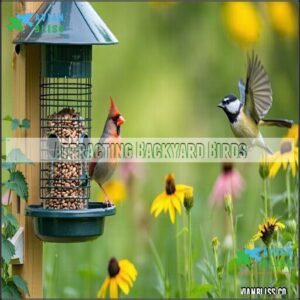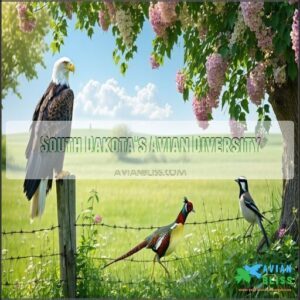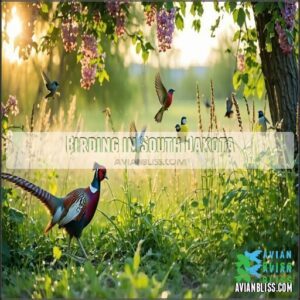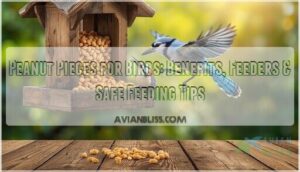This site is supported by our readers. We may earn a commission, at no cost to you, if you purchase through links.
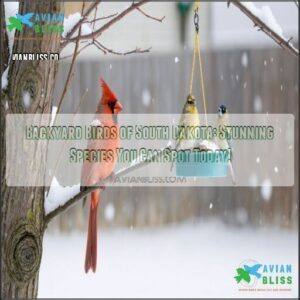
In eastern regions, you might spot Baltimore Orioles, while western areas host Mountain Bluebirds.
Dark-eyed Juncos become winter regulars, hopping beneath feeders like little vacuum cleaners. Many birds adapt their diets seasonally, switching from insects to seeds as temperatures drop.
The right feeder setup can transform your yard into a bird sanctuary even during harsh prairie winters, making it an ideal place for backyard birds of South Dakota to thrive, and allowing you to enjoy Northern Cardinals and other species throughout the year, which is a great way to attract American Goldfinches.
Table Of Contents
- Key Takeaways
- Common Backyard Birds
- Bird Identification by Color
- Attracting Backyard Birds
- South Dakota’s Avian Diversity
- Birding in South Dakota
- Frequently Asked Questions (FAQs)
- What is the most common bird in South Dakota?
- Are blackbirds common in North and South Dakota?
- How many bird species are there in South Dakota?
- What bird flies in South Dakota?
- When are birds most commonly spotted in South Dakota?
- What hummingbirds live in South Dakota?
- How do I identify birds in my backyard?
- What is South Dakota’s state bird?
- What happened to my backyard birds?
- What birds are in the Black Hills of South Dakota?
- Conclusion
Key Takeaways
- You’ll spot a diverse range of species in South Dakota, from colorful American Goldfinches and Northern Cardinals to adaptable Black-capped Chickadees that visit feeders year-round.
- Your location within South Dakota determines which birds you’ll see, with Mountain Bluebirds in western regions, Baltimore Orioles in eastern areas, and habitat-specific species in urban, rural, wooded, wetland, and grassland environments.
- You can attract more birds by installing different feeder types (tube, platform, suet), offering appropriate seeds (black oil sunflower, nyjer, millet), planting native vegetation, providing water sources, and setting up nesting boxes.
- You’ll enhance your birding experience by visiting popular spots like Lake Andes National Wildlife Refuge, joining seasonal events such as the Dakota Birding Festival, or learning bird identification techniques that focus on color, behavior, and habitat.
Common Backyard Birds
You can spot a variety of fascinating birds right in your backyard, whether you’re in a bustling city or a quiet rural area.
Backyard bird watching brings nature’s theater to your doorstep – no ticket required.
From the American Robin’s orange chest to the Red-winged Blackbird’s striking wing patches, South Dakota’s feathered visitors never disappoint.
Birds Found in Urban Areas
In South Dakota, urban areas are bustling with backyard birds adapted to city life.
House sparrows, European starlings, and common grackles thrive amidst buildings and parks, showcasing their resourcefulness.
Bright blue jays add color, while American crows dominate with their sharp intelligence.
Urban bird diets include seeds, insects, and scraps, making bird feeders a magnet for these adaptable creatures.
Listen for urban bird sounds—chirps, calls, and caws echo across city bird habitats.
Watch closely; bird building nests is a marvel of ingenuity!
Birds Found in Rural Areas
The vast countryside offers a haven for farm birds and field habitats, making rural areas great for spotting south Dakota birds.
Watch for red-winged blackbirds calling from fences or mourning doves cooing softly in open fields.
Backyard birds thrive near barns and hedgerows, creating lively nesting sites.
- Common sightings: Northern flickers drumming on poles.
- Habitats: Gardens, farmland, pastures.
- Bird-friendly tip: Plant native grasses to support rural conservation and attract diverse, common birds.
Birds Found in Wooded Areas
Heading from open farmlands to shaded woodlands, you’ll find unique south dakota birds thriving in forested habitats. These backyard birds bring a chorus of forest birdsong and fascinating behaviors to watch.
Look out for woodpeckers like the Downy Woodpecker and Northern Flicker—expert cavity nesters—tapping for bugs inside tree trunks. Spot Black-capped Chickadees, perfect canopy dwellers, darting between branches while White-breasted Nuthatches scuttle downward like acrobats.
Blue Jays flash with flair, filling the woods with their bold "jay-jay" cries. Wooded areas are ideal bird habitats teeming with diverse bird species.
Enjoy bird identification in these spaces as shrubland birds bring life to your backyard woods.
Birds Found in Wetlands
Exploring South Dakota’s wetlands reveals hidden gems among marsh birds and other fascinating species.
These bird habitats bustle with life, offering endless surprises.
You might see:
- Pied-billed Grebes gracefully gliding, their chunky bills perfect for catching fish.
- American Coots, quirky swimmers known for their diving skills and unique movements.
- Franklin’s Gulls, masters of migratory patterns, gathering in awe-inspiring flocks.
Wetland habitats are vibrant ecosystems, essential for shorebird diets and migratory journeys.
Visiting these areas connects you to the beauty of South Dakota birds thriving in their natural spaces.
Birds Found in Grasslands
The grasslands of South Dakota are a haven for prairie birds, offering endless opportunities for bird watching and bird identification. From Western Meadowlarks showcasing their tunes to the elusive Upland Sandpiper, these vast fields teem with life.
- Western Meadowlarks dominate the landscape, their songs a Meadowlark Habitat staple.
- Harriers glide effortlessly on prairie breezes.
- Grassland Nesting Pheasants thrive here year-round.
- Sparrows scurry through grasses, promoting backyard bird conservation efforts. Many sparrows thrive in backyards and fields and eat seeds and insects.
Bird Identification by Color
You can identify many backyard birds in South Dakota just by their color, making it easier to spot specific species.
Look for blue, black, red, yellow, or brown patterns to help narrow down the options quickly.
Blue Birds
Bluebirds are a treat for bird watchers across South Dakota, adding a pop of vibrant color to your yard.
Eastern Bluebirds frequent open fields and suburban areas, while Mountain Bluebirds favor the Black Hills. Their bright blue and orange feathers make identification easy.
To attract these backyard birds, create ideal Bluebird Habitats with nesting boxes and native plants. They’ll swoop in for mealworms and berries. Males flaunt dazzling sky-blue feathers, while females sport softer tones.
| Aspect | Eastern Bluebird | Mountain Bluebird | Habitat | Diet |
|---|---|---|---|---|
| Male coloration | Bright blue | Sky blue | Fields and meadows | Mealworms, berries |
| Female tones | Grayish-blue | Pale gray-blue | Near Black Hills | Insects, small fruits |
Black Birds
Black birds bring a bold presence to South Dakota’s backyards, showcasing striking traits and behaviors.
Their iridescent feathers shimmer in sunlight, adding a splash of drama to everyday birdwatching.
- Common Grackles flash purple-green hues while displaying fascinating grackle behavior.
- Black-capped Chickadees charm with tidy black-and-white patterns and playful energy.
- Red-winged Blackbirds flaunt fiery red wing patches, a hallmark of molting plumage.
- European Starlings dazzle with speckled iridescent feathers.
- Brown-headed Cowbirds prefer subtle dark tones, thriving in varied blackbird habitats.
Red Birds
A flash of crimson feathers through your South Dakota backyard signals nature’s showstoppers. Among the vibrant red birds, you’ll often spot the Northern Cardinal, House Finch, and Red-winged Blackbird.
Species Key Features Habitat
Cardinal habitats thrive best with shrubs for nesting. Finch varieties flock to feeders brimming with sunflower seeds. Red-winged Blackbirds love wetland spots for breeding behaviors.
Their bold plumage variations inspire every birdwatcher! Overall, color patterns aid in bird identification.
Yellow Birds
Yellow birds bring cheer to your backyard in South Dakota, making bird identification exciting and fun.
Identifying Yellowbirds is easy once you notice their vibrant plumage. They thrive in various Yellowbird Habitats and enjoy feeding on seeds, insects, and berries.
Here’s a quick guide to Local Yellowbirds:
- American Goldfinch: Year-round visitor with bright yellow feathers and black wings.
- Yellow Warbler: All-over yellow perfection.
- Common Yellowthroat: Black mask stands out.
- Yellow-rumped Warbler: Splashes of yellow.
- Yellow-headed Blackbird: Bold yellow head steals attention.
Brown Birds
You’ll notice plenty of brown-toned birds blending into South Dakota’s landscapes. These backyard birds use camouflage to thrive in their habitats, making identifying browns both fun and rewarding.
The Brownheaded Cowbird, known for nesting in other birds’ homes, often surprises Chipping Sparrows.
Here’s a quick guide to some fascinating brown birds:
| Bird Species | Beak Type | Nesting Materials |
|---|---|---|
| House Sparrow | Seed-crushing | Grass, straw |
| Dark-eyed Junco | Fine, pointed | Soft materials |
| Brown Thrasher | Long, curved | Twigs, roots |
Watch for sparrows and thrashers as they feed and interact—they’re a joy to observe.
Attracting Backyard Birds
You’ll transform your South Dakota yard into a bird haven with the right mix of feeders, seeds, plants, water sources, and shelter.
Creating this perfect bird-friendly space lets you enjoy daily visits from robins, chickadees, and meadowlarks while supporting local bird populations.
Types of Bird Feeders
In South Dakota yards, the right bird feeder transforms your outdoor space into a bustling avian hotspot.
Tube feeders attract chickadees and goldfinches with their multiple ports and seed protection.
Ground feeders invite juncos and doves to feast without flying up.
Platform feeders serve as open dining tables for many South Dakota backyard birds, including cardinals and blue jays.
Suet feeders become winter magnets for woodpeckers and nuthatches when temperatures drop.
Peanut feeders draw in jays and titmice with high-protein treats.
For best results, place feeders near protective shrubs but away from predator hiding spots.
Many prefer using specialized seed cylinders in tube feeders.
Clean your bird feeders monthly to prevent disease.
Different feeder types attract different species, so mixing styles creates a diverse backyard bird community in your South Dakota home.
Types of Bird Seed
The right bird seed turns your feeder setup into a South Dakota avian hotspot. Now that you’ve got your feeders in place, let’s fill them with the perfect mix.
Different birds prefer specific seed types, and using the right ones will maximize your backyard visitors. Black oil sunflower seeds work like magic for attracting cardinals, chickadees, and nuthatches due to their high oil content and easily cracked shells.
Your seed selection should include:
- Nyjer seed (thistle) for goldfinches and pine siskins
- White millet varieties for ground-feeding juncos and sparrows
- Suet cakes for woodpeckers, especially during cold Dakota winters
Store your birdseed in airtight containers to prevent mold and keep pests away. Understanding safflower’s bitter taste can help deter squirrels from your feeders. Many South Dakota birds appreciate seed mixes that combine their favorites, but avoid cheap fillers like red millet or flax that often go uneaten.
Bird-Friendly Plants
Native plants create nature’s pantry for backyard birds while saving you water and maintenance time.
Plant these South Dakota favorites to attract specific feathered visitors:
| Plants | Bird Visitors |
|---|---|
| Purple Coneflowers | Sparrows & Finches |
| Sunflowers | Goldfinches |
| Virginia Creeper | Mockingbirds |
| Dogwoods | Thrushes |
| Trumpet Honeysuckle | Orioles |
Berry-producing shrubs offer both food and shelter plants for protection. Species with high seed production like milkweed attract birds directly and support insect attraction, creating a complete feeding system.
Consider exploring South Dakota flora for your garden. Your bird-friendly garden becomes a conservation hotspot with every native addition.
Bird Baths and Ponds
Bird bath sanctuaries serve as essential water sources for South Dakota’s backyard birds.
Place your bath in a shady spot with nearby perches, keeping it 1-2 inches deep for robins and chickadees. For larger species like grackles, include deeper sections up to 4 inches.
Clean weekly and refresh water daily to prevent mosquito breeding. Use rough-textured materials that offer good footing, and consider adding a small pump for moving water that attracts more bird diversity.
In winter, heated baths become indispensable water sources when natural options freeze. Your simple bath can transform into a lively hub of feathered activity year-round, providing a vital source of water that supports bird diversity.
Nesting Boxes and Shelters
Well-designed nesting boxes turn your backyard into a cozy neighborhood for South Dakota’s feathered families.
Different birds need specific homes to feel comfortable settling in:
- Black-capped Chickadees prefer small houses with 1.1-inch holes, mounted 5-15 feet high
- American Robins welcome open-fronted shelters under protective eaves
- Downy Woodpeckers seek deeper boxes with 1.5-inch entrance holes
- House Wrens thrive in simple boxes with 1-inch openings
Smart box placement is essential—face openings northeast to avoid harsh sun exposure.
Install predator guards below boxes to keep raccoons and snakes away. Size matters too; larger birds need roomier quarters.
Consider various nesting box options for different species. Regular maintenance tips: clean houses each fall, repair damage, and replace worn materials.
Your backyard birds will thank you for creating a welcoming environment with these simple steps.
South Dakota’s Avian Diversity
You’ll find over 410 bird species throughout South Dakota, from the tiny Calliope Hummingbird to the majestic Bald Eagle with its impressive 8-foot wingspan.
Whether you’re watching from your window or exploring local parks, you can spot everything from common backyard visitors like Black-capped Chickadees to the state’s official bird, the colorful Ring-necked Pheasant.
Sparrows and Finches
After setting up those bird-friendly feeders, you’ll discover the diverse world of sparrows and finches right in your South Dakota backyard.
These small songbirds come in surprising variety – with twenty-six sparrow species and fourteen finch species calling the state home.
| Species | Habitat | Seed Preferences |
|---|---|---|
| House Sparrow | Man-made structures | Seeds, berries, food waste |
| House Finch | Throughout state | Almost exclusively seeds |
| Song Sparrow | Wet, shrubby areas | Grass seeds, insects |
Look for House Sparrows (our most common winter bird) building nests in cavities, while House Finches bounce through the air in their distinctive flight pattern.
The elusive swamp sparrow prefers wetlands and is less likely to visit feeders, making it a unique sighting in the South Dakota backyard.
Waterfowl and Shorebirds
While sparrows and finches delight in your backyard feeders, South Dakota’s wetlands host an impressive array of waterfowl and shorebirds you won’t want to miss.
The state’s prairie pothole region serves as nature’s perfect habitat for these water-loving birds.
When exploring South Dakota’s wetlands, you’ll spot:
- Sandpipers and yellowlegs probing mudflats with specialized bills
- Elegant great blue herons standing statue-still before striking for fish
- Colorful wood ducks nesting in tree cavities near water
- Massive flocks of snow geese creating living clouds during migration
- Western grebes performing synchronized water-dances during courtship
These shorebird migrations and waterfowl gatherings make wetland conservation essential for South Dakota’s bird diversity.
Raptors and Birds of Prey
While majestic raptors soar across South Dakota’s diverse landscapes, you can spot many of these powerful birds of prey right from your backyard.
The state hosts an impressive variety of predatory birds that play vital roles in Dakota wildlife ecosystems.
| Raptor Type | Regional Species | Hunting Techniques | Nesting Habits |
|---|---|---|---|
| Hawks | Red-tailed, Cooper’s | Perch hunting from poles | Tree crowns |
| Owls | Great horned, Screech | Night ambush tactics | Hollow trees |
| Eagles | Bald, Golden | Soaring surveillance | Tall trees near water |
| Falcons | Peregrine, Kestrel | Fast aerial pursuit | Cliff ledges |
The table provides an overview of the different raptor types, including their regional species, hunting techniques, and nesting habits.
Songbirds and Warblers
While raptors command the skies, South Dakota’s songbirds fill your yard with enchanting melodies.
During warbler migration, these backyard birds transform gardens into natural concert halls.
- Yellow Warblers inhabit riparian areas, their sweet "sweet-sweet-sweet-a-little-more-sweet" songs perfect for birdsong identification
- Black-and-White Warblers crawl along tree trunks in deciduous woodlands, showing unique nesting behavior
- Orange-crowned Warblers prefer forest canopies, their conservation status making each sighting special
Song Sparrows round out these songbird habitats with their rich, varied tunes throughout South Dakota, creating a natural concert.
Birds of Conservation Concern
Several beloved South Dakota backyard birds face serious threats from habitat loss and climate change.
The Common Grackle, once abundant, has declined by nearly 30% due to:
- Pesticide use reducing insect food sources
- Invasive species competing for nesting sites
- Agricultural expansion eliminating native grasslands
You can support bird conservation efforts by planting native vegetation, reducing chemical use in your yard, and participating in local conservation programs that protect essential habitats for these threatened species.
By taking these steps, you contribute to the preservation of biodiversity and the well-being of the environment, ultimately supporting the local ecosystem.
Birding in South Dakota
You’ll find over 400 bird species throughout South Dakota’s diverse landscapes, from prairies to wetlands.
With a good pair of binoculars and a field guide, you can spot everything from the state bird Ring-necked Pheasant to colorful songbirds right in your own backyard.
Best Birding Spots in South Dakota
South Dakota’s diverse landscapes offer remarkable birding spots where you can witness the state’s rich avian diversity up close.
Head to Lake Andes National Wildlife Refuge to spot over 240 species, or explore the Mountain Trails in the Black Hills for forest dwellers.
Don’t miss Waubay’s prairie landscapes or the river valleys at Lacreek Refuge.
These birdwatching locations showcase the best of South Dakota’s feathered residents across Lakes and Rivers, State Parks, and Seasonal Hotspots.
Birding Events and Festivals
Looking beyond great birding locations, you’ll find exciting birdwatching events throughout South Dakota’s festival calendar.
Experience our rich avian diversity through seasonal celebrations where beginners and experts alike gather.
- Attend the Christmas Bird Count (December-January) for community science participation
- Visit the Dakota Birding Festival in May featuring beginner workshops
- Explore conservation-focused events by the Prairie Hills Audubon Society
- Join the Sioux Falls Bird Club’s migration watches with fellow enthusiasts
Check local event highlights for upcoming birdwatching festivals near you!
Birding Tours and Guides
Birding enthusiasts can enhance their South Dakota experience through guided adventures.
Local experts reveal hidden hotspots and share identification tricks you won’t find in books.
| Tour Provider | Expertise | Location | Tour Type | Cost Range |
|---|---|---|---|---|
| Dakota Birding | Waterfowl | Eastern SD | Half-day | $45-75 |
| Black Hills Tours | Forest Species | Western SD | Full-day | $95-150 |
| Prairie Guides | Grassland Birds | Central SD | Weekend | $200-350 |
| Missouri River Excursions | Riparian Species | Central/Eastern | Boat Tours | $75-125 |
| Badlands Birding | Raptors | Western SD | Photography | $125-175 |
Birding Tips and Techniques
While guided tours offer expert insights, mastering your own birding skills transforms every backyard visit.
Equip yourself with quality binoculars and South Dakota-specific field guides. Practice ethical birding by keeping a respectful distance from nests.
Learn sound identification—many birds are heard before seen. Fill bird feeders with appropriate seeds and observe quietly, as sudden movements scare away visitors.
For beginners, try bird photography with a simple camera to document your finds. Remember, patience rewards you with stunning sightings of chickadees, meadowlarks, and even elusive warblers.
Frequently Asked Questions (FAQs)
What is the most common bird in South Dakota?
According to bird checklists, the American Robin is your most common bird in South Dakota, appearing on 36% of records. You’ll see these red-breasted beauties more frequently during summer months.
Are blackbirds common in North and South Dakota?
Yes, blackbirds are common in both Dakotas. Red-winged Blackbirds appear on 29% of South Dakota checklists, especially in summer. Common Grackles, another blackbird species, are seen on 23% of checklists year-round.
How many bird species are there in South Dakota?
South Dakota boasts around 410 bird species throughout the year. You’ll find anywhere from 352 to 440 species on official lists, depending on the source and when counts were last updated.
What bird flies in South Dakota?
Just as you open your window, you’ll see over 410 bird species flying in South Dakota.
From American Robins to Red-winged Blackbirds, these feathered friends take to the skies year-round or seasonally.
When are birds most commonly spotted in South Dakota?
Birds are most active in South Dakota during summer months, especially in mornings.
You’ll spot American Robins, Red-winged Blackbirds, and Mourning Doves from May through August during their breeding and feeding periods.
What hummingbirds live in South Dakota?
You’ll find four hummingbird species in South Dakota: Ruby-throated as the most common, plus occasional visitors like Rufous, Calliope, and Broad-tailed. Ruby-throated hummers typically arrive mid-May through September during migration.
How do I identify birds in my backyard?
Isn’t it wonderful to spot nature’s treasures right outside your window?
Look for key features like size, color patterns, behavior, and habitat.
Use field guides or bird ID apps for accurate identification.
What is South Dakota’s state bird?
South Dakota’s state bird is the Ring-necked Pheasant. You’ll recognize this introduced Asian species by the male’s colorful plumage with iridescent blue-green head, white collar, and red eye patches.
What happened to my backyard birds?
Several factors could explain their disappearance: seasonal migration, habitat changes, food scarcity, predators, or weather fluctuations. You’ll likely see them return when conditions improve, especially during their preferred season.
What birds are in the Black Hills of South Dakota?
Perched high and nestled low, you’ll spot American Dippers along Spearfish Creek, Red-naped Sapsuckers in forests, and Mountain Bluebirds in meadows.
The Black Hills’ unique ecosystem’s also home to Western Tanagers and Red Crossbills.
Conclusion
Whether you’re a seasoned birder or just getting started, backyard birds of South Dakota offer year-round enjoyment.
You’ll discover that providing the right combination of food, water, and shelter transforms your yard into a vibrant ecosystem.
By hanging diverse feeders and planting native species, you’re not just creating a sanctuary—you’re contributing to conservation efforts.
So grab your binoculars, fill those feeders, and watch as South Dakota’s feathered friends bring your backyard to life.
